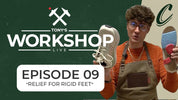
From Pain to Relief: Treating Rigid Feet with Custom Orthotics
, by Tony Chiappetta , 9 min reading time

, by Tony Chiappetta , 9 min reading time
truggling with rigid feet and chronic pain? Discover how Chiappetta Shoes custom orthotics target foot rigidity with cushioning and expert support.
If you’re struggling with foot pain—especially due to age, arthritis, or years of wear and tear—the right orthotic solution can make all the difference. In Episode 9 of "Workshop Live," Tony Chips dives into a hands-on review of a common but often-misunderstood issue: the rigid, aging foot (referred to as an "A1 foot type") and the meticulous modifications that go into solving persistent pain.
Below, we’ll break down how Tony’s approach directly addresses foot discomfort, plus the importance of custom tailoring orthotics for real-world relief.
Tony introduces a customer with an "A1 foot type": a bony, rigid foot that has become increasingly stiff over the years. This foot has seen plenty of action and, as he points out, has developed issues in both the toes and forefoot. The customer’s history includes previous orthotics, but with changed needs and added pain, it was time for a new solution—one involving more cushioning and strategic support.
The condition of rigid feet often leads to rigid feet pain, particularly in areas where the joints no longer flex naturally. This lack of mobility can make walking, standing, or even wearing standard footwear uncomfortable—especially as foot rigidity increases with age or past injuries.
Recognizing that stiff feet lack natural shock absorption, Tony selected a four-layer custom orthotic:
This thoughtful layering isn't arbitrary—it’s tailored to absorb impact, redistribute pressure, and address pain points unique to a rigid, previously pronated foot.
During a two-week checkup, the customer shared their progress: good comfort on the left foot but ongoing cramping and metatarsal pain on the right.
Here’s how Tony dialed in on the solution:
The materials used (55 durometer EVA and cushioned cork) strike the right balance—soft enough for comfort, but firm enough for real support.
Understanding the difference between rigid feet vs flexible feet is essential when it comes to treatment. Rigid feet, often the result of aging, arthritis, or structural foot abnormalities, tend to be stiff with limited joint movement. These feet struggle to absorb shock and adapt to uneven terrain, which leads to increased stress on other joints like the knees and hips.
In contrast, flexible feet are more adaptable and can distribute pressure more evenly. While flexible feet can also experience problems (like overpronation), they usually benefit more quickly from simple orthotic support.
For rigid foot types , the approach must be much more strategic. Modifications need to carefully manage foot rigidity, redistribute pressure, and offer both shock absorption and control.
Targeted Pressure Relief: Pads and bars redistribute force across the foot, taking strain off sensitive joints or nerves.
Shock Absorption: Multiple cushioning layers absorb daily impacts, reducing jarring pain for those with stiff, inflexible feet .
Customization: No two feet (or bodies) are exactly alike—Tony’s process ensures every inch of padding or support is in the right place for the right reason.
If you or someone you know is experiencing rigid feet pain, our certified pedorthic experts are here to help! We offer free foot assessments, make custom orthotics in-house, and provide free orthotic adjustments.






